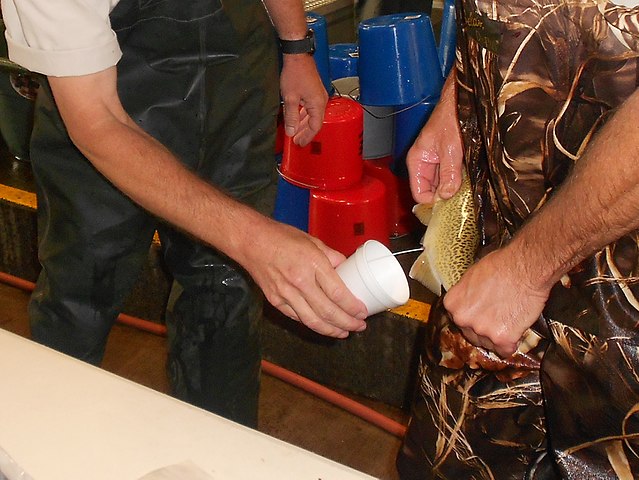Top Qs
Timeline
Chat
Perspective
Milt
Fish seminal fluid and sacs From Wikipedia, the free encyclopedia
Remove ads
Milt is the seminal fluid of fish, mollusks, and certain other water-dwelling animals. They reproduce by spraying this fluid which contains the sperm, onto roe (fish eggs). It can also refer to the sperm sacs or testes that contain the semen.

Milt (sometimes spelled melt[1][2]) or soft roe[3] also refers to the male genitalia of fish when they contain sperm, used as food. Many cultures eat milt, often fried, though not usually as a dish by itself. As a food item, milt is farmed year-round in nitrogen tanks, through hormone induction or photoperiod control.[4]
Remove ads
Production
Summarize
Perspective
Production of milt may be affected by external stimuli. Goldfish are known to produce more milt when isolated from other males in their group,[5][6] but will continue to produce high levels even when exposed to the scent of an unfamiliar male, suggesting that milt production is affected by close contact to rival males.[6] Milt production is also stimulated by the scent of a female fish.[5] Milt itself may contain pheremones that attract ovulating females.[7]

Intersex fish are less likely to release milt, or may fail to produce milt at all, due to their sperm ducts being blocked.[8] Even when intersex fish do produce milt, the sperm density is lower than normal, and the sperm that is present typically has less motility than normal.[9] Triploid fish can sire offpring, but said offspring have low hatch rates and high mortality rates.[10] For this reason, some hatcheries may intentionally produce triploid fish to keep them from hybridizing or competing with native fish.[11]
Chemical composition of milt varies slightly by species. Herring milt is 82.5% water, 2% fat, 16.7% protein, and 2% ash for fish with 21% milt. Cod milt is 82% water, 1.1% fat, 14.5% protein, and 1.8% ash.[12]
Remove ads
Use in captive breeding
Summarize
Perspective

At fish hatcheries, workers manually squeeze milt out of male fish, then use the milt to fertilize harvested eggs. This can be done to many fish while alive, and afterwards the fish can be released.[13] Pacific salmon hatcheries are an exception; the fish, returning from migration,[14] are killed via a guillotine and then the milt is poured over eggs, either by squeezing the male over them or by putting the milt in a dropper and squeezing it in.[15]
After collection, milt may be refrigerated for brief periods of time to increase sperm motility. Pacu milt, for example, will still have live sperm after 8 hours, and the motility will be higher compared to milt stored at room temperature.[16] This is not true of all species, however; the longer the milt of the steelhead trout is stored, the higher the mortality rate of the hatchlings it produces.[17]
Milt removed from dead fish can still be fertile hours after the fish's death. A blacktail redhorse's milt, for one, is still fertile an hour after the fish has died;[18] chinook salmon milt, for another, is still fertile up to five hours after the fish has died.[17] Milt is still fertile even if the fish it came from was killed by piscicide.[18]
Remove ads
Milt as food
Summarize
Perspective
Though many North Americans find the consumption of milt taboo,[19] it is popular in many Asian and European cuisines, and has been called "the male counterpart to caviar".[20]
Asian cuisine
- In Indonesian cuisine, the milt (called telur ikan 'fish egg') of snakehead and snapper is usually made into kari or woku.
- In Japanese cuisine, the testes (白子 shirako 'white children') of cod (tara), anglerfish (ankō), salmon (sake), squid (ika) and pufferfish (fugu) are eaten.[21]
- In Korean cuisine, the milt (이리 iri) of Alaska pollock, cod, blackmouth angler, bogeo, and sea bream are eaten.
European cuisine
- In Romanian cuisine, the milt of carp and other fresh water fish is called lapți (from the Latin word lactes) and is usually fried.
- In Russian cuisine, herring milt (молока, moloka) is pickled the same way as the rest of the fish, but eaten separately, sometimes combined with pickled herring roe. Various whitefish soft roes are usually consumed fried and it is an inexpensive everyday dish.
- In Sicilian cuisine, the milt of tuna is called lattume and is used as a typical pasta topping.[22]
- In British cuisine, cod soft roes are a traditional dish, usually fried in butter and spread on toast.
- In Czech cuisine, the milt of common carp called mlíčí (from the Czech word mléko - milk) is often used in a fish soup served on Christmas Eve dinner.
- In Ashkenazi Jewish cuisine, kratsborscht is a sauce made from milt.[23]
- Japanese shirako (cod milt) gunkanmaki
- Smelt milt
Other uses
Milt is highly absorbent of rare earth elements such as neodymium and iron. The heavier the rare earth element, the higher its affinity for milt.[24] Because of this, it has been proposed as an environmentally-friendly way to recover rare earth elements from waste.[24]
See also
Wikimedia Commons has media related to Milt.
References
External links
Wikiwand - on
Seamless Wikipedia browsing. On steroids.
Remove ads



